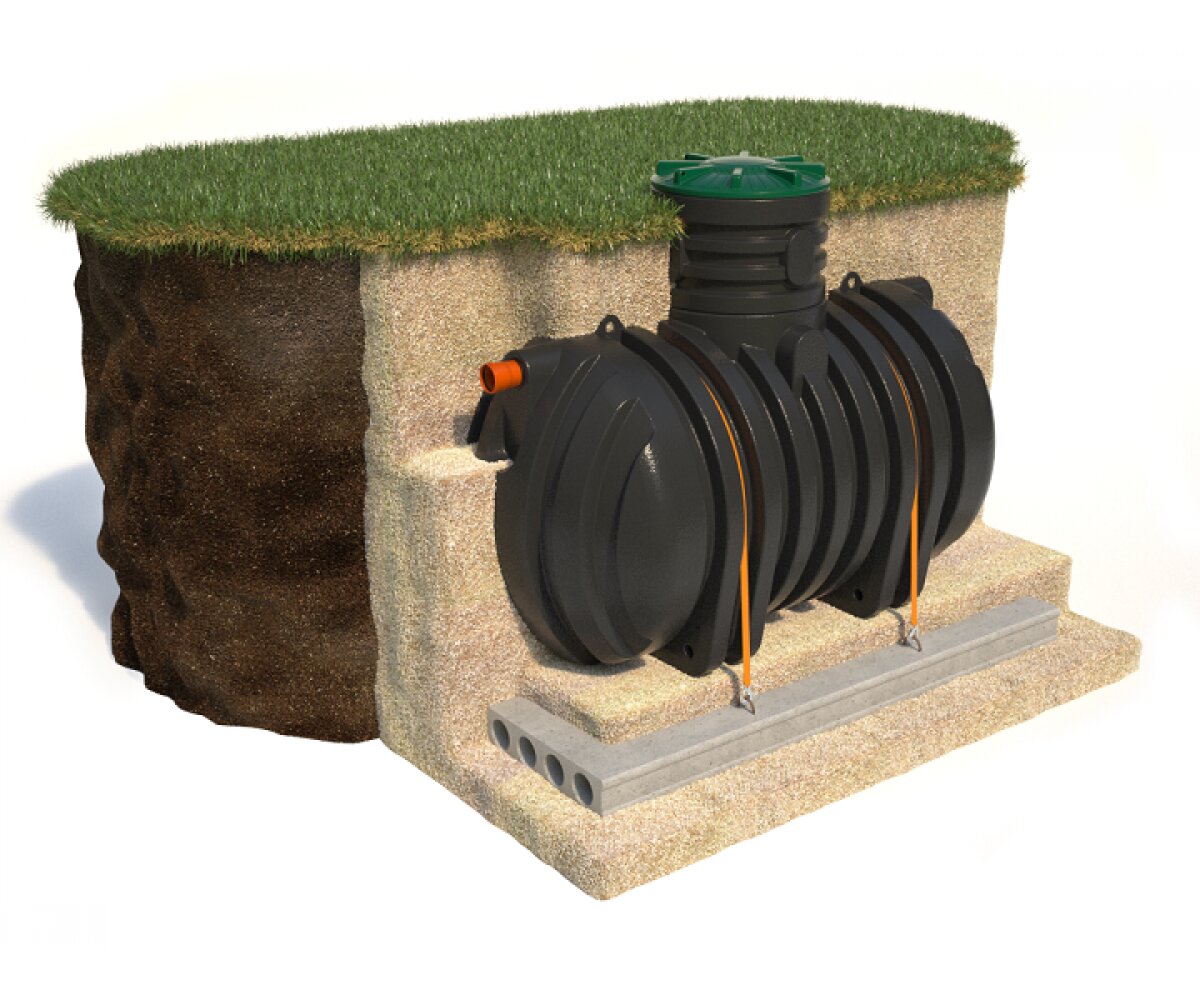Comfortable life in the countryside surrounded by wildlife depends on the availability of some of the benefits of civilization. The optimum minimum requirements include electricity and drinking water. All that remains is to decide on the choice of a purification device (septic tank) for a private house, and you can enjoy the beauty of nature not only in summer on weekends, but also all year round.
Septic tank is a capacious tank or several communicating chambers, where domestic sewage flows down. The more complex the device of the septic tank, the more effectively the wastewater is treated. When choosing the right model, many factors are taken into account, including the number of users and the intensity of sewer use.
Most sewage systems are tanks, where the effluent is purified in stages, decomposing into sludge and water. The simplest septic tanks are made from car tires, concrete rings, brickwork by hand or buy ready-made factory designs. The purpose of operation of any system is to ensure safe disposal of solid waste, minimizing the negative impact on the environment.
The basic principles of septic tank operation
- Sewage from the house through a pipe is directed by gravity to the primary chamber, where it is defended.
- Anaerobic bacteria process the mass, as a result of which it separates sludge and water.
- The volume of the tank should be sufficient for a three-day discharge. This is the length of time that the bacteria process the sewage mass.
- The clarified water flows into the next chamber, which plays the role of a filtration well. Unlike the first sealed container, the second one is made without a bottom. Instead of it, a drainage layer is created from a mixture of sand with gravel and crushed stone. Water, seeping through the drainage bottom, is filtered and absorbed into the ground.
Choosing the right septic tank device
On how autonomous septic tanks work, the comfort of living in the house depends. The advantages of septic tanks are reduced to the durability of the design, the absence of unpleasant odors on the site, reducing environmental pollution. The disadvantages are considered to be the increased amount of excavation work and the high cost of tanks.
Choosing between a modern septic tank and a classic cesspool, evaluate the main differences between the systems:
- The method of liquid effluent utilization. The cesspool only accumulates sewage until the tank fills up to the stage when it is necessary to call an assassinization technique. Septic tank does not just accumulate, but cleans the liquid wastewater by 70-80%.
- The number of tanks. Waste pit – a single storage, and the septic tank usually has 2-3 chambers with different functionality.
- Maintenance. The liquid from the pit is pumped out by the assenizators as the tank is filled. Depending on the load on the sewer system and the volume of the pit, order their services once every 2-3 months. Septic tank is cleaned from accumulated sludge no more than once a year.
- Regularity of use. At the dachas, where the family is chosen only for the weekend, from a financial point of view it is advantageous to build a primitive cesspool. For houses with permanent residence are more suitable septic tanks, capable of processing a larger amount of effluent.
How a septic tank works, taking into account the method of treatment
There are a number of factors that determine the quality of the septic tank: design, the device of compartments and additional structures, the method of purification. All systems are divided into 2 varieties – with ground filtration and full bio purification.
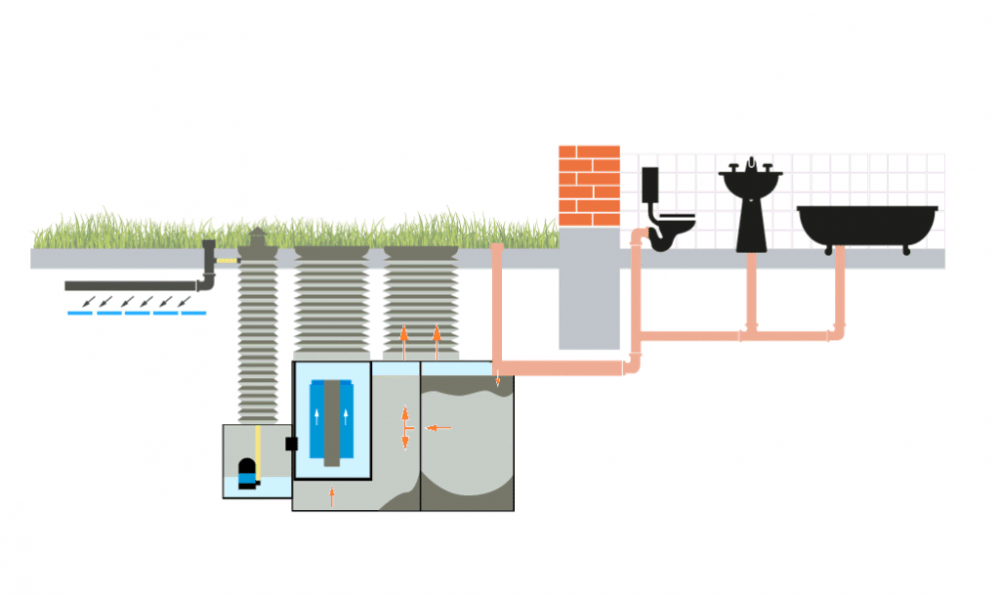
The method of ground filtration works due to the force of gravity. It is known that liquid waste is about 90-95% water, and the remaining 5-10% are impurities. The latter, having settled, settle to the bottom. In a two-chamber septic tank, the final cleaning occurs due to the seepage of effluent through a layer of crushed stone. In three-chamber designs, soil purification occurs in the third chamber or the effluent is discharged to the ground filtration field. The latter has to be constructed in areas with high groundwater.
The method of bio purification provides high efficiency. The principle of operation of such a septic tank is based on the action of biological enzymes. Waste is processed by microorganisms, the vital activity of which must be maintained.
Septic tank: installation scheme
Legislation obliges to comply with a number of regulations concerning the construction of a septic tank on the site: the device, design, scheme of laying communications are strictly regulated by sanitary requirements. Before starting any work on the site, it is required to develop a project and coordinate it.
To develop the project, it is necessary to specify the rates for installation, materials, earthwork.
Preparation for installation involves the calculation of parameters affecting the location of the septic tank on the site. The course of preparatory work:
- Analyzing the relief and composition of the soil.
- Assessment of the level of groundwater.
- Preparation of the site.
- Marking.
- Digging an excavation for the tank and trenches for communications.
Then it remains to install the septic tank, connect it and put it into operation. When contacting professionals, all activities take no more than one or two days.
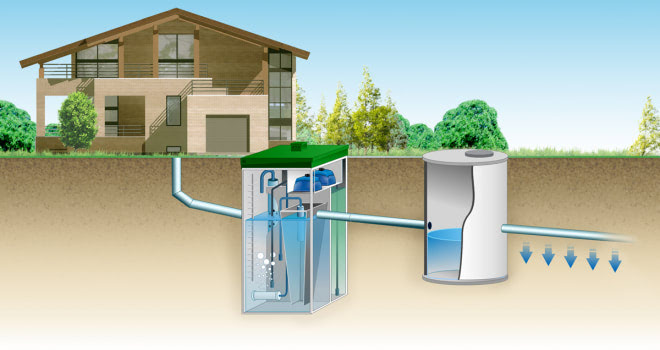
How septic tanks with different cleaning technologies are arranged
To clean the effluent coming from the house, use different schemes of septic tank arrangement.
The traditional scheme is a classic 3-chamber tank, and the first 2 chambers are hermetic, in them anaerobic decomposition of impurities is carried out. As the liquid is purified, it moves through overflow pipes to the third chamber, which plays the role of a filtration well. The last tank is not airtight. Instead of the day, a layer of crushed stone is poured, through which the clarified liquid is absorbed into the ground. Given that organics decompose with the release of gas, in such a scheme there is necessarily ventilation. Professionals will remove the air ducts so that the unpleasant odor does not enter the residential house.
A treatment scheme with a filtration site is necessary in areas with high groundwater. In the tank, the effluent is first decomposed to a fine silt mixture and clarified water. The latter is forced by pumps to the filtration field. These are trenches filled with crushed stone.
Biofilter is another method of wastewater treatment. It represents a container with drainage material – expanded clay, crushed stone, plastic “ruffs”. For quality aftertreatment requires a spacious plot of land. Thanks to the use of microorganism colonies, wastewater is purified by 95% against 85% in the previous variant. The pre-cleared effluent from above falls on the biofilter and under the influence of gravity it flows through the drainage, passing biological and mechanical purification in parallel.
How the energy-dependent septic tank works in a private house
If the device of a dacha septic tank has an aerotank, it turns into a bio purification system. Such a station provides effective filtration, does not need to build a filtration field or a well. The main purification is carried out in the chamber-aerotank. A colony of aerobic bacteria processes organics, dividing it into simple components.
For maintenance of such septic tanks do not need to call assenizators – it is enough to have a mamut-pump, which is pumped out the excess sludge. Cleaning is carried out about once every 6 months to prevent siltation of the pump. If this happens, the activated sludge will need to be pumped out with a drainage pump.
Septic: a multi-stage cleaning device
Understanding the principle of operation of septic tanks in private households, comes with a dative study of the design and purpose of its components.
From the house through the sewer pipe, located with a slope, wastewater enters the first chamber of the septic tank. Here the substance is decomposed into fractions: large solid contaminants settle to the bottom, and water with small suspended solids moves into the next chamber. Here anaerobic microorganisms start to work. In the first two chambers, active fermentation takes place and methane is released. The entrances to the compartments are closed by gates from the water flow, so unpleasant odors do not spread outside.
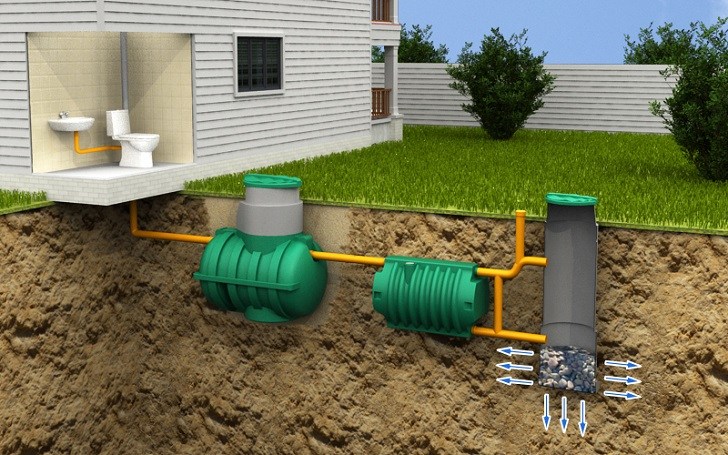
Clarified effluent enters the third chamber, where it passes through a removable filter that captures residual contaminants. In parallel, the liquid is treated by aerobic bacteria. They need oxygen to live, which is pumped into the tank by a compressor. Then the water purified to the required level is discharged into the ground or sewage ditch.
Proper operation and maintenance will ensure the absence of unpleasant odors on the site, and with this safe and effective disposal of liquid household waste.
Suitable septic tank for a private house: principle of operation and design features
Before choosing a particular model of septic tank device, the design is evaluated by the completeness and purpose of its constituent elements. There are different modifications, but most of them are characterized by the following components:
- Tanks for settling the effluent. Accumulation tanks are made of plastic, metal, concrete or brick. The most preferred models are made of fiberglass and polypropylene – the materials are resistant to abrasion and guarantee the tightness of the tank during the entire life cycle.
- Incoming and outgoing piping. Overflow spigots are installed at a slope, ensuring unobstructed flow of liquid between the tanks.
- Maintenance Elements. Inspection manholes and manholes. A minimum of one manhole shall be installed on the outside route of the sewer line. If the length of the branch increases more than 25 meters, an additional revision is arranged.
- Ventilation system. Regardless of what bacteria (anaerobic or aerobic) are involved in the processing of sewage, for the normal vital activity of microorganisms, methane removal and maintenance of the desired temperature requires air exchange.
Septic tank: the principle of step-by-step operation and the device of compartments
If desired, it is not difficult to understand the principle of septic tank operation: the sewage system functions according to the principles of gravity settling and biofiltration (natural or forced). The sequence of cleaning stages for many models of factory septic tanks is standard:
- The treatment system is a sealed tank that includes one or more compartments.
- The septic tank chambers are separated by partitions. The movement of liquid between them is carried out by overflow pipes.
- To the first compartment from the internal sewerage system of the house is connected drain pipe, and from the last chamber to withdraw purified water into the ground or semi-purified – on the soil aftertreatment.
How biological septic tanks work
To learn more about the work of biological septic tank (what it is), the principle of operation of the device is considered through the prism of design features and cleaning technology. The structure is a station of deep purification, working on the basis of the vital activity of microorganisms. The design is performed in the form of a sealed block with stiffening ribs. The internal structure of the septic tank is divided into sections. The more sections, the higher the degree of purification. Standard – 95% and more. Processes occurring in the chambers of the bioseptic:
- The first chamber performs the role of a settling tank. Here the sewage is divided into particles of heavy and light fractions, forming a floating film and sediment, and processed by anaerobes that do not need oxygen supply.
- In the second compartment, organic and inorganic wastes are decomposed by aerobic microorganisms that require a regular supply of oxygen to carry out processing and their own vital activity.
- In the third chamber, the filtered wastewater is disinfected with chemical components or re-exposed to aerobic bacteria.
For the activation of aerobic microorganisms in the chambers of the septic tank must be supplied with oxygen – the device is equipped with an aerator. Therefore, most of the biotreatment stations are energy-dependent.
How the septic tank is completed for complete purification
When choosing a septic tank for a dacha, the principle of operation of the device is evaluated taking into account the requirements for the aftertreatment system. There are different ways to bring the level of purification to comply with the norms. Ground aftertreatment is used in overflow structures, where the liquid flows from tank to tank and is separated naturally. The mechanical method provides about 65% of cleaning, so the septic tank is additionally completed.
The device of the simplest septic tank
When choosing the cheapest and simplest in terms of the device of the septic tank in the dacha, you can stop at the accumulation tank. This is a single-chamber solid construction, designed for the temporary storage of accumulated waste. As soon as the tank is filled, call the collectors for pumping. The dimensions of the tank are selected taking into account the average daily volume of wastewater on the site. The system can be equipped with a check valve and an alarm system with a level sensor.
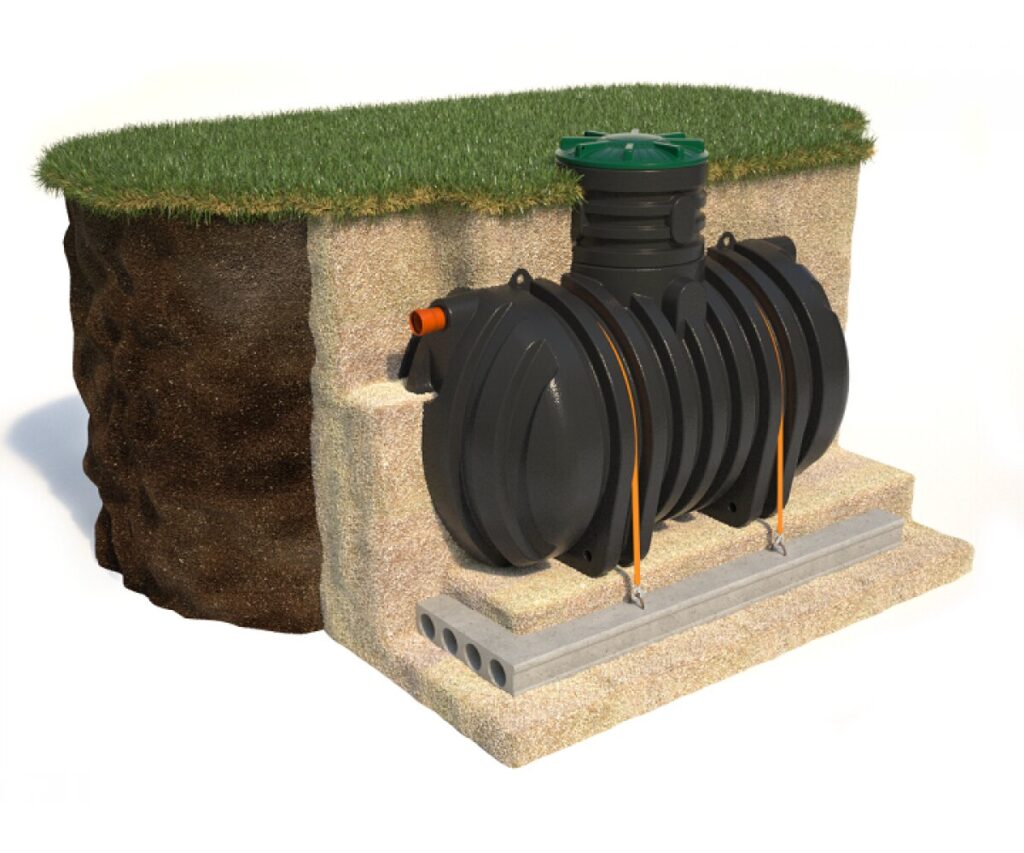
If you are interested in the most efficient and productive system, we offer modern bio-septic and aeration systems: we will promptly deliver, professionally install and responsibly run the treatment plant. Leave an application form or contact our experts to find out more.
- A hermetically sealed tank consisting of one or more compartments. The chambers in the tank are separated by partitions with overflow connections for the movement of liquid. Storage tanks are homemade (concrete, brick) and factory-made (plastic, metal). The most reliable are tanks made of polypropylene and fiberglass.
- The primary (receiving) compartment is connected to the drain pipe from the house, from the final purification chamber water is discharged into the ground or to the soil aftertreatment, if not brought to the required level of purification. Incoming and outgoing pipes and spigots in the system are installed at an angle for the natural movement of liquid.
- A mechanical filter is included in many models. Due to filtration through expanded clay, gravel and sand, sediment is separated without the use of chemicals.
- Manholes and inspection wells are provided for service maintenance of the autonomous sewerage system. According to regulations, there should be at least one manhole on the outer route of the pipeline leading to the sewerage system. If the length of the pipeline exceeds 25 meters, an additional revision is required.
- Ventilation system – a mandatory addition to the septic tank. It is necessary to maintain heat exchange, methane removal, aeration. Simple ventilation includes one riser at the very beginning of the system and the second – in the last chamber. If filtration fields are constructed, ventilation risers are installed on each drainage pipe.
- Filtration well. This is a special structure without a bottom, the role of which can also perform a layer of crushed stone 1 m thick.
- Cleaning field under the ground. It is a system of perforated pipes laid in gravel and sand backfill.
- Filter trenches. Two tiers of pipes are laid in the trenches: upper – irrigation, lower – drainage. The clarified effluent enters the upper pipe, seeps through the holes and dooocleanizatsya through the sand with crushed stone, collected in the lower pipe and on it is withdrawn to the place of discharge.
How the septic tank works
- Primary treatment of wastewater from the house entering the first compartment or tank. Large particles are sifted out, heavy suspended solids are precipitated, and the lighter ones are lifted to move to the next stage of treatment.
- Decomposition of heavy constituents. The waste from the bottom of the first chamber ferments and decomposes for 3 days. The result is a thick mass, water and carbon dioxide. At this stage, the effluent purification rate reaches 60%, which is not enough for safe disposal.
- The wastewater is moved to the second chamber for re-cleaning. Here the sewage is decomposed. In some models, bacteria and reagents are connected to the work, breaking down the mass into simple components.
- Drainage of treated effluent. At this stage, the path of clarified sewage depends on the type of septic tank. If the level of purification reaches 95%, the water is used for technical needs on the site. If it is necessary to increase the level of purification, a drainage well, filtration fields and other additional facilities are used.
- The wastewater settles, heavy particles settle, and light particles float on the surface. Anaerobic bacteria process the organics.
- Waste is processed by aerobic bacteria.
- The filtered water flows out of the secondary sedimentation tank and the activated sludge settled in it flows back into the aeration tank.
